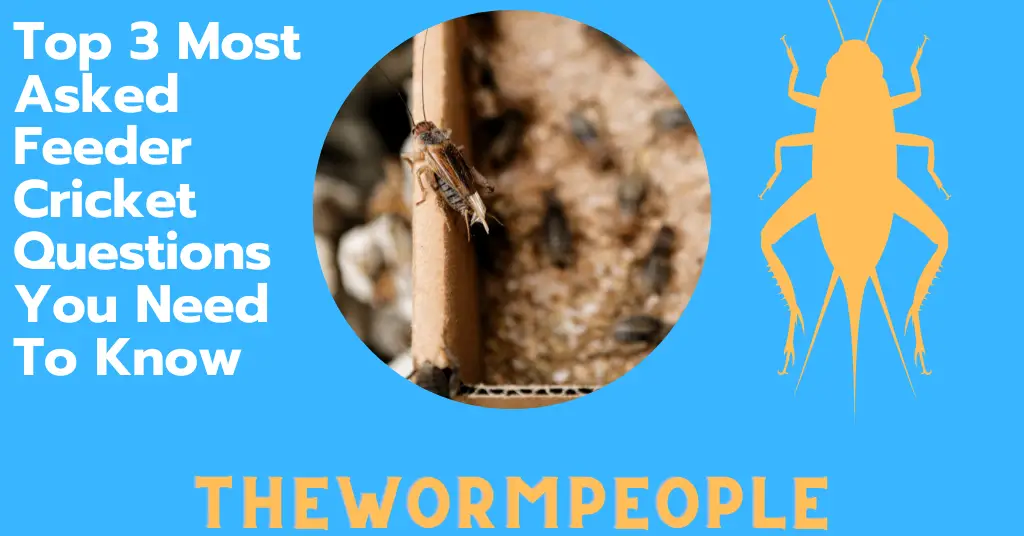
Jeffery Jago is a expert in horticulture and worm breeding. With a background in plant cultivation
Last Updated on July 11, 2021 by Jeffery Jago
These are the most common questions I get asked either through email or Facebook groups.
If you found these answers useful, please share them around so I can answer fewer questions on repeat!
How Long Do Feeder Crickets Live
The average feeder cricket lifespan is 10 weeks max from birth to death. This lifespan can be cut down significantly with inadequate humidity of 60-75% and heating. It’s important to keep your feeder container above 70 degrees for your feeders, otherwise, their lifespans will be significantly shortened.
What to Look For When Ordering Live Crickets
When ordering live crickets online, there are a few things you should check to be sure you’re going to get exactly what you paid for without any dead crickets or other unexpected surprises.
- Consider if the online shop you are purchasing from has a live delivery guarantee in place. This is important if something beyond your control happens and the crickets die, You will be sent a replacement batch at no cost to yourself (or with extra shipping and handling, it depends on the store) or given store credit.
- Be aware that these policies may only be in place on a seasonal basis. The season depends on the type of insect, but in the case of crickets, it’s usually spring/summer/fall.
- Consider their shipping policy for certain temperature ranges for that week. A lot of places will hold back shipping until the weather is more ideal (IE: Not too cold or too hot) in your area.
- Do they offer a non-guaranteed shipping option? It could be important they offer this in winter if you are in desperate need to take a chance shipping below 16F.
- Have they been recommended by breeder and feeder forums? Do they have solid reviews around the web?
- Consider if a local source is a better fit than buying online. Not only do you support local breeders, but you also save a small fortune on shipping costs!
Why Do My Feeder Crickets Keep Dying
Crickets can die for a ton of reasons. Without more details, it’s hard to say what exactly would have killed your crickets, but there are some things that are pretty common that would.
- Stress – When crickets are placed in new environments, they can become stressed and either refuse to eat or refuse to stay hydrated. Make sure you have a consistent supply of water and/or food as well.
- Weather – High temperatures can kill feeder crickets quickly if there’s not enough access to water or shelter.
- Humidity is too low, it should be kept at a solid 60% minimum, ideally around 75%
- It’s too cold, Keep heat at 70F
- There is mold in the enclosure, or you’ve got an explosion of bacteria. Be sure to clean the frass out at least twice a week and remove old food. Keep the enclosure as dry as possible other than the humidity. It can be a hard balance!
- Parasites! We will get into that below.
What Are Common Feeder Cricket Parasites
Horsehair worms are one of the more common parasites you’ll encounter when dealing with feeder crickets. They are small worm-like creatures that live in the gut of your feeders, meaning that while they do not kill them right away, it does cause a significant intestinal blockage and can lead to death overtime.
They will also wiggle out once the host dies. It’s quite terrifying to witness firsthand.
Gordian worms are another common parasite of crickets. These worms will worm their way into the cricket host, wrapping themselves around the cricket’s insides until the cricket is dead and they can burst out for freedom.
With all that said, While being the most common parasites, they’re also fairly rare for feeder crickets to have parasites at all.
Really the only time you have to worry about them is if you’re introducing wild crickets or buying from a sketchy breeder.
You should be far more concerned with mites. Most crickets you get are going to have at least 1 mite attached to them.
Mites are easy enough to control, However, if the little red mites grow out of control it may be time to sanitize the entire enclosure.
if you see white mite-like creatures, do not fret, these are probably springtails and are completely harmless.

